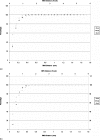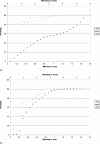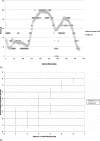Evaluation of guidewire path reproducibility
- PMID: 18561663
- PMCID: PMC2673644
- DOI: 10.1118/1.2903430
Evaluation of guidewire path reproducibility
Abstract
The number of minimally invasive vascular interventions is increasing. In these interventions, a variety of devices are directed to and placed at the site of intervention. The device used in almost all of these interventions is the guidewire, acting as a monorail for all devices which are delivered to the intervention site. However, even with the guidewire in place, clinicians still experience difficulties during the interventions. As a first step toward understanding these difficulties and facilitating guidewire and device guidance, we have investigated the reproducibility of the final paths of the guidewire in vessel phantom models on different factors: user, materials and geometry. Three vessel phantoms (vessel diameters approximately 4 mm) were constructed having tortuousity similar to the internal carotid artery from silicon tubing and encased in Sylgard elastomer. Several trained users repeatedly passed two guidewires of different flexibility through the phantoms under pulsatile flow conditions. After the guidewire had been placed, rotational c-arm image sequences were acquired (9 in. II mode, 0.185 mm pixel size), and the phantom and guidewire were reconstructed (512(3), 0.288 mm voxel size). The reconstructed volumes were aligned. The centerlines of the guidewire and the phantom vessel were then determined using region-growing techniques. Guidewire paths appear similar across users but not across materials. The average root mean square difference of the repeated placement was 0.17 +/- 0.02 mm (plastic-coated guidewire), 0.73 +/- 0.55 mm (steel guidewire) and 1.15 +/- 0.65 mm (steel versus plastic-coated). For a given guidewire, these results indicate that the guidewire path is relatively reproducible in shape and position.
Figures





Similar articles
-
Real-time endovascular guidewire position simulation using shortest path algorithms.Int J Comput Assist Radiol Surg. 2009 Nov;4(6):597-608. doi: 10.1007/s11548-009-0385-z. Epub 2009 Jul 18. Int J Comput Assist Radiol Surg. 2009. PMID: 20033336
-
An improved real-time endovascular guidewire position simulation using shortest path algorithm.Med Biol Eng Comput. 2016 Sep;54(9):1375-82. doi: 10.1007/s11517-015-1398-0. Epub 2015 Oct 15. Med Biol Eng Comput. 2016. PMID: 26467345
-
MR versus fluoroscopic guidance of a catheter/guidewire system: in vitro comparison of steerability.J Magn Reson Imaging. 1998 Sep-Oct;8(5):1177-81. doi: 10.1002/jmri.1880080526. J Magn Reson Imaging. 1998. PMID: 9786159
-
Guidewire path determination for intravascular applications.Comput Methods Biomech Biomed Engin. 2016;19(6):628-38. doi: 10.1080/10255842.2015.1055732. Epub 2015 Jul 15. Comput Methods Biomech Biomed Engin. 2016. PMID: 26176911
-
Basics of Guidewire Technology and Peripheral Artery Disease.Semin Intervent Radiol. 2023 Jun 16;40(2):129-135. doi: 10.1055/s-0043-57258. eCollection 2023 Apr. Semin Intervent Radiol. 2023. PMID: 37333742 Free PMC article. Review.
Cited by
-
Real-time endovascular guidewire position simulation using shortest path algorithms.Int J Comput Assist Radiol Surg. 2009 Nov;4(6):597-608. doi: 10.1007/s11548-009-0385-z. Epub 2009 Jul 18. Int J Comput Assist Radiol Surg. 2009. PMID: 20033336
-
Treatment Planning for Image-Guided Neuro-Vascular Interventions Using Patient-Specific 3D Printed Phantoms.Proc SPIE Int Soc Opt Eng. 2015 Feb 21;9417:941726. doi: 10.1117/12.2081997. Epub 2015 Mar 19. Proc SPIE Int Soc Opt Eng. 2015. PMID: 26778878 Free PMC article.
-
Design Optimization for Accurate Flow Simulations in 3D Printed Vascular Phantoms Derived from Computed Tomography Angiography.Proc SPIE Int Soc Opt Eng. 2017 Feb 11;10138:101380R. doi: 10.1117/12.2253711. Epub 2017 Mar 13. Proc SPIE Int Soc Opt Eng. 2017. PMID: 28663663 Free PMC article.
-
Method to simulate distal flow resistance in coronary arteries in 3D printed patient specific coronary models.3D Print Med. 2020 Aug 6;6(1):19. doi: 10.1186/s41205-020-00072-7. 3D Print Med. 2020. PMID: 32761497 Free PMC article.
-
Use of patient specific 3D printed neurovascular phantoms to simulate mechanical thrombectomy.3D Print Med. 2021 Sep 27;7(1):32. doi: 10.1186/s41205-021-00122-8. 3D Print Med. 2021. PMID: 34568987 Free PMC article.
References
-
- Kochanek K., Murphy S. L., Anderson R. N., and Scott C., “Deaths: Final Data for 2002,” Natl. Vital Stat. Rep. ZZZZZZ 53, 44 (2004). - PubMed
-
- Haring H. P., Trenkler J., Aichner F. T., Topakian R., and Berek K., “The current status of carotid artery angioplasty and stenting,” ACNR 4(4), 12–16 (2004).
-
- Gary S., Roubin G., New G., Iyer S. S., Vitek J. J., Al-Mubarak N., Liu M. W., Yadav J., Gomez C., and Kuntz R. E., “Immediate and late clinical outcomes of carotid artery stenting in patients with symptomatic and asymptomatic carotid artery stenosis: A 5-year prospective analysis,” Circulation CIRCAZ 103, 532–537 (2001). - PubMed
Publication types
MeSH terms
Substances
Grants and funding
LinkOut - more resources
Full Text Sources
Other Literature Sources
Research Materials

